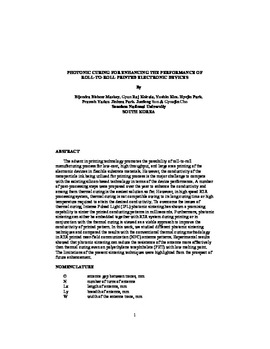| dc.contributor.author | Maskey, Bijendra Bishow | |
| dc.contributor.author | Koirala, Gyan Raj | |
| dc.contributor.author | Kim, Yushin | |
| dc.contributor.author | Park, Hyejin | |
| dc.contributor.author | Yadav, Pravesh | |
| dc.contributor.author | Park, Jinhwa | |
| dc.contributor.author | Sun, Junfeng | |
| dc.contributor.author | Cho, Gyoujin | |
| dc.contributor.other | International Conference on Web Handling (2019) | |
| dc.date.accessioned | 2019-06-04T16:16:36Z | |
| dc.date.available | 2019-06-04T16:16:36Z | |
| dc.date.issued | 2019-06 | |
| dc.identifier | oksd_icwh_2019_maskey1 | |
| dc.identifier.citation | Maskey, B. B., Koirala, G. R., Kim, Y., Park, H., Yadav, P., Park, J., Sun, J., & Cho, G. (2019, June). Photonic curing for enhancing the performance of roll-to-roll printed electronic devices. Paper presented at the Fifteenth International Conference on Web Handling (IWEB), Stillwater, OK. | |
| dc.identifier.uri | https://hdl.handle.net/11244/320261 | |
| dc.description.abstract | The advent in printing technology promotes the possibility of roll-to-roll manufacturing process for low-cost, high throughput, and large area printing of the electronic devices in flexible substrate materials. However, the conductivity of the nanoparticle ink being utilized for printing process is the major challenge to compete with the existing silicon-based technology in terms of the device performance. A number of post-processing steps were proposed over the year to enhance the conductivity and among them thermal curing is the easiest solution so far. However, in high speed R2R processing system, thermal curing is not compatible owing to its long curing time or high temperature required to attain the desired conductivity. To overcome the issues of thermal curing, Intense Pulsed Light (IPL) photonic sintering has shown a promising capability to sinter the printed conducting patterns in milliseconds. Furthermore, photonic sintering can either be embedded together with R2R system during printing or in conjunction with the thermal curing is viewed as a viable approach to improve the conductivity of printed pattern. In this work, we studied different photonic sintering techniques and compared the results with the conventional thermal curing methodology in R2R printed near-field communication (NFC) antenna patterns. Experimental results showed that photonic sintering can reduce the resistance of the antenna more effectively than thermal curing even on polyethylene terephthalate (PET) with low melting point. The limitations of the present sintering techniques were highlighted from the prospect of future enhancement. | |
| dc.format | application/pdf | |
| dc.language | en_US | |
| dc.publisher | Oklahoma State University | |
| dc.rights | In the Oklahoma State University Library's institutional repository this paper is made available through the open access principles and the terms of agreement/consent between the author(s) and the publisher. The permission policy on the use, reproduction or distribution of the article falls under fair use for educational, scholarship, and research purposes. Contact Digital Resources and Discovery Services at lib-dls@okstate.edu or 405-744-9161 for further information. | |
| dc.title | Photonic curing for enhancing the performance of roll-to-roll printed electronic devices | |
| osu.filename | oksd_icwh_2019_maskey1.pdf | |
| dc.type.genre | Conference proceedings | |
| dc.type.material | Text | |
